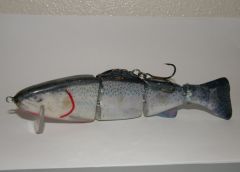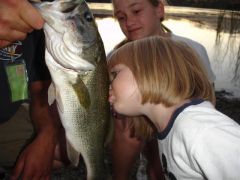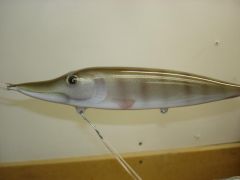-
Posts
14,726 -
Joined
-
Last visited
-
Days Won
364
Content Type
Profiles
Articles
TU Classifieds
Glossary
Website Links
Forums
Gallery
Store
Everything posted by mark poulson
-
-
I think any decopage-type material, like Etex, is going to be more flexible, because it has to be able to move with the large wood surfaces it covers. In the 70's I used the early version of Crystal Sheen for rod wraps, and it stayed flexible, too. I think Downriver would be the person who could really answer this question better.
-

My 1st swimbait. any advice would be great.
mark poulson replied to newcastledrew's topic in Hard Baits
A-MAC, That's a really clever lure maker! I'm jealous. -
BobP, You and Nathan B. helped me solve a mismatched paint problem when I first visited this site two years ago, and that kept me painting and building. So I have you to blame!!!! Thanks again.
-
I'd get the Plus. You can do almost everything with it. I bought a cheap brush with a smaller needle to do detail work, but I learned that I can do fine work by just adjusting the paint valve on the HP-C Plus. I feel kind of dumb. I've owned and used compressors for most of my adult life, and still don't know the difference in fittings by name. I just take whatever I want to match down to the lumber yard or tool repair store, and match it all up. Once you've gotten your air brush and hose, a lot of these questions will probably answer themselves. It's really not complicated.
-
I'm disappointed. Being from Montana, I thought you were a cowboy? Just funnin'. I really think how people conduct their private lives is their own business, as long as it doesn't harm anyone else. I think most of us have enough trouble just trying to keep our lives together, without worrying about everyone else. But I finally saw that movie on cable a couple of months ago, and I found it strange. Not something I'd watch twice, but it was challenging to watch. Made me think about how I think about other people and their lifestyles, and the assumptions I make. Like the saying goes, "You never know a man until you walk a mile in his shoes". I don't think I'd want to walk in those shoes, but that movie made me look at it from a different perspective, for sure. And I'm not going to make a batch of brokeback lures!
-
Jimbo, I got mine at the Home Depot near my house, in the paint department. It's called Minwax Wood Hardener, and it comes in a yellow metal can shaped like a pop bottle. If I were you, I'd google Home Depot and see if they list it as something they carry. They may have stopped, but it's used a lot by painters to repair rotten wood before they bondo and paint. Home Depot also has a store locator, plus you can look up what products each store carries, I think. I also found it on a couple of websites by googling Minwax Wood Hardener.
-
-
I read your question as wanting brokeback photos, and got a little concerned. Then I put on my glasses. Those photos from Sinbad are great. I'd love to screw up enough courage to try foil/photo finishes. Is it just me, or does a Blueback Herring look like a big shad?
-
I use the cheap photo program that came with my first Nikon digital camera. It's called Picture Project. When I've made the editing changes I want, I email the pictures to myself, save them in my documents, and then upload them to the gallery from my documents, three at a time. But I found I can't upload them as a set, or the file is too big. Try hitting "NO" in the box that asks if you want to upload them as a set, and see if the works. When my daughter gets home from school, I'll ask her about the file size I use. I'm clueless.
-
It's 2:00 in the afternoon, pouring rain, and 40+ degrees right now, and I'm about to go out to my unheated garage to "whip up" a reversed joint lure. I thought about it, and it's going to be easier to just make a new one than to try to rework the old one. So the new one will be out of PVC, and will be the same body design and paint scheme as the last 7" lures I made. That way, I think I'll have a true comparison so I can see what, if any, difference the reversed joints make.
-
I think Snax is right about lighter woods being more lively. I've used fir, pine, and poplar in the past for surface gliders. Of the three, I like pine the best for surface, punker-type gliders, because it's light, so the ballast at the bottom make it bottom heavy and less likely to roll and more lively. Yet it's strong, too. But the wood is softer than the other two, so I coat/soak it with Minwax Wood Hardener, both to seal it and to make the surface harder. Recently I made two punker-type gliders out of PVC decking. They are a little heavier than wood gliders, so they have less ballast and more of a tendency to walk almost submerged on a fast retrieve. I finished them in a white belly/sides and grey back "sexy shad" paint scheme, and they are really visable in low light and choppy water. The PVC can be worked with tools almost like wood, and is totally waterproof, so any nicks in the top coat epoxy don't let in any water. But they are rock hard, and haven't nicked or chipped so far when I've introduced them to the local rocks. And they cast a mile.
-
matt, If you soak the pieces for ten minutes, one coat should be enough. It is a penetrating wood preservative. When you put it in to soak, you should see it chasing little air bubbles out of the wood as it penetrates the wood cells. Once it cures in there, any other coats are just surface, since the wood itself is now sealed. After you let the first coat cure for 24 hours, lightly sand the surface, and you're ready to prime and paint. A tip. Avoid touching the lure with your bare fingers. Finger print oil screws up paint and top coats. Either handle the lure with a rag, or use disposable latex gloves (thank you Pete). I use a glove on my left hand, since I'm right handed and do most of the painting with my right hand. I hold the lure, or lure parts, in my left hand, clamped in a pair of forcepts or needle nose vice grips, while I paint it with my right hand. No "human" contact with the lure itself. I hang it on opened up paper clips over my work bench between coats, so I can use both hands to clean the air brush and reload it. By avoiding the human touch, I don't have any "fish eye" problems from oil contamination.
-
Use a good dust mask for sawdust and sanding dust, and a respirator for solvents and fumes and painting/finishing.
-
If you can swing it financially, go with the Iwata HP-C. You can do almost anything with that brush, the quality is tops, and you'll never need another brush.
-
You guys have inspired me. I just took apart and stripped down a 4 piece wooden swim bait I made early this year, because the top coat split along an old crack. I had repainted this once already, sanding the old epoxy and painting over it, without stripping it down to bare wood. In hindsight, I think that was a mistake. I think I'll take advantage of having to repaint this bait, and play around with making the joints reversed, if I can, like the BBZ shad, and see how it swims. As I'm sitting here typing, I'm wondering to myself how much of the lure I'll lose by recutting the joints, but, what the heck, I think it's worth a try.
-
Dieter, Bubble gum is a pink color that was the color the original baseball card chewing gum, and most other bubble gum, chewing gum that you could blow bubbles with, came it. I don't know how they came up with the pink color, but, as kids, we didn't think it was real bubble gum unless it was pink. CA Delta, I wouldn't worry about if the lure will catch fish because of the paint job. Dieter has a signature at the bottom of his posts that says every lure will catch fish sometimes, or words to that effect. Finish it, fish it, and, if you feel like, in the future, you want a different paint scheme, repaint it. I do that to my older lures, from earlier attempts, if I like the lure's action, but don't like the paint scheme, or want to "improve" it with my newer "paint skills". I actually have two older baits hanging over my workbench right now, wait to be reworked and repainted.
-
-
-
Good point, Dave. That's why I always drill out the potential ballast location holes before I seal and test.
-
Dumb question #2 Can you mix and match Createx water and solvent based paints?
-
Hijack. Dumb question, I'm sure. Why do we put big eyes on crawdad cranks (I do it, too)?
-
How many segments does your 12" bait have? I went to the 4 section baits after seeing that the original triple trout didn't swim well at slow speeds. In my 4 piece lures, the head is twice the size of the other sections, which are about the same length, not counting the plastic add-on tail. A 2/1/1/1 ratio. And the ballast, other than a weighted hook hanger in the third section, is all in the head. I made some 3 piece bluegill/crappie lures that have a 1/1/1 ratio, and they do swim well at slow speeds, but all the ballast, aside from the weighted hook hanger again in the last section, is in the head, too. If anything, I err on the side of too loose on the joints. I want the smooth flow of water down the sides to be interrupted by the joint, and for the joints to swing really easily. It may also have to do with how you shape your joints. I've seen, and own, some swimbaits whose meeting joint faces are almost flat, but I've never tried that. In the past, I've use a nesting, male-female joint, with the concave face on the back of the sections, and the convex (male) face on the front of the sections. I cut the female joint at 12 1/2 degrees, and make the male joint more pointed, to give the joints more room to move. The new BBZ 4" shad has reversed joint faces with the concave facing forward, and I'm going to make one like that. I asked Bill Siemental why he did it that way, and he said that it was the only way he could get the bait to swim at all speeds, which it does great. Bill Siemental has a forum on his website, www.thebbz.com, and if you go on there and post your questions, he'll answer your questions. He's been making swimbaits forever, and helped develop all the currently popular baits, so he's the guy to ask. He's house bound right now, waiting for knee surgery, or he may have already had it and be home recuperating, so it's a great time to ask him.
-
That's a heavy multiple coat base coat of opaque white Createx, or multiple coats of Krylon white primer, Auto air aluminum over that, multiple coats until I get good coverage, and scales of Wldlife sparkle white, three coats to get a good buildup. Next comes a coat of pastel fixative after the scaling, in case I mess up the next colors. Three coats of moss green darkened with trans. med brown on the back and shoulders, and more shading of med. brown on the back. Sometimes I'll do a white belly, silver sides, and then scale. Then accents of irridescent violet on the cheeks and maybe that, or flamingo pink light stripe down the side. I spray a coat of silver glitter over that, and then two coats of Nu Lustre. On a smaller lure it may only be 2-3 grams, but I err on the side of guessing heavier when I'm compensating for the weight of the finish. It's easier for me to make a finished lure a little heavier, by either adding some more ballast, or another coat of epoxy, or bigger/heavier hooks and split rings, than it is to try to lighten it after it's finished. Finding where the ballast is so I can drill some out after it's painted is tricky. I guess I could actually weigh the epoxy before I add it, and try to do the same for all the paint and glitter, but it was easier for me to weigh the lure before and after finishing, so that's how I arrived at 3-4 grams for a 10" four piece jointed bait. I'm sure this is where the disclaimer is supposed to go, like, "Your results may vary. Consult a physician if your problem lasts more than four hours". In reality, how heavy you make your coats, how big you make your bait, what kind of epoxy, how many coats of it, all those are variables. When one of my first "floaters" became a suspending slow sink after I'd finished and epoxied it, I figured I'd better be a little more precise in my weighting. So I did a before and after weighing of the next lure I finished, and that's what I came up with. Two #7 split shots.
-
Sounds like you've got it sorted out and you're on the right path. Slow sink lures generally have enough ballast to let you burn them without them rolling over, like some floaters do. Especially tall bodied floaters. Slow sink lures are great for rip/pause/rip retrieves, as well as jerk/ jerk/jerk retrieves. The first one attracts the fish on the rip, and they hit it on the pause. The second one simulates a struggling fish. With both of them, since the lure sinks slowly, it will sit almost motionless on the pause, staying in one place, as opposed to a faster sinking lure that might sink too quickly. So your "error" might turn out to be a success. Errors aren't really failures if you learn from them. A recent rework of a lure I made that started off as an "error" is a good example of what I'm talking about. I made a jointed lure out of a big punker-type glider, and had to redo the joints to get it to swim. It only swims at med. speeds, but it's a great twitch bait. The last time I threw it, I was doing a jerk/jerk struggling trout retrieve, when, all of a sudden, there was a grey torpedo coming up behind it at warp speed. I realized that it wasn't a fish, so I burned it back to the boat. Just as I lifted it from the water, a cormorant surfaced behind where it had just been, with a weird look on it's face, like I'd snatched it's dinner. Funny as heck. But it showed me that the lure had a realistic struggling fish presentation. And that I need bigger trebles. I can't wait to throw it when they stock trout again, and the big bass and stripers come up and feast on them.





